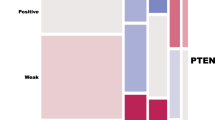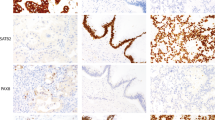Abstract
The aim of this study was to analyse the clinical significance of Cathepsin D (Cath D) content as determined by an immunoradiometric assay in a series of primary untreated ovarian cancers from 162 patients. In addition, immunohistochemical analysis of Cath D was also performed on a subset of 86 tumours. Cath D levels were distributed in an asymmetrical way and were skewed towards the lower values (median value 20.8 pmol mg(-1) protein, range 2.0-99.0 pmol mg(-1) protein). No correlation was found between Cath D levels and clinicopathological parameters. However, the percentage of Cath D positivity was significantly higher in oestrogen receptor-positive (57%) compared with oestrogen receptor-negative (36%) cases (P= 0.01). The percentage of Cath D-positive staining was not significantly different for both epithelial (27%) and stromal components (40%). Immunoradiometrically detected Cath D levels were not different according to Cath D stromal immunostaining (P= 0.18), while higher Cath D levels were measured in Cath D-positive than in Cath D-negative tumour epithelial cells (P = 0.027). Survival analysis was conducted on 161 primary untreated ovarian cancer patients. The 5-year overall survival rate was 57% and 55% in Cath D-positive and Cath D-negative patients respectively (P = 0.69). As far as time to progression was concerned, there was no significant difference in the survival rate of patients with either high or low Cath D content (P = 0.56). Similar results have been obtained in the subset of patients in which Cath D was analysed by immunohistochemistry. In conclusion, Cath D measurement in tumour extracts appears to have a limited usefulness in improving the prognostic characterization of ovarian cancer patients.
This is a preview of subscription content, access via your institution
Access options
Subscribe to this journal
Receive 24 print issues and online access
$259.00 per year
only $10.79 per issue
Buy this article
- Purchase on Springer Link
- Instant access to full article PDF
Prices may be subject to local taxes which are calculated during checkout
Similar content being viewed by others
Author information
Authors and Affiliations
Rights and permissions
About this article
Cite this article
Ferrandina, G., Scambia, G., Fagotti, A. et al. Immunoradiometric and immunohistochemical analysis of Cathepsin D in ovarian cancer: lack of association with clinical outcome. Br J Cancer 78, 1645–1652 (1998). https://doi.org/10.1038/bjc.1998.737
Issue Date:
DOI: https://doi.org/10.1038/bjc.1998.737
This article is cited by
-
The potential prognostic value of cathepsin D protein in serous ovarian cancer
Archives of Gynecology and Obstetrics (2012)



